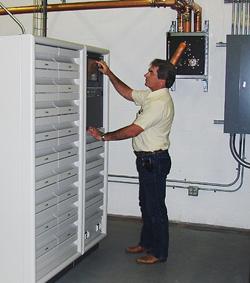Texas Station Goes 'Platinum' With Harris

Mark Cormier checks out operating parameters on KBMT's new Harris Platinum-i transmitter.BEAUMONT, TEXAS
KBMT is an ABC/NBC affiliate that serves this southeast Texas market. Our engineering team has been working on digital conversion for most of 2009, gearing up for the June 12 goodbye to analog broadcasting.
We had been broadcasting digitally on Channel 50 for some time, but it became too costly to maintain a UHF operation so we opted to revert to back to our Channel 12 assignment. This required a new VHF DTV transmitter, and after careful consideration, the station purchased a Harris Platinum-i solid-state model.
Our choice was mainly driven by support and reliability. We'd been using a Harris BT Series tube transmitter since 1977, and its reliability was amazing. Even though Harris had long ago ceased making the BT Series, their support staff was always able to answer any questions and point us to spare parts.
TRANSMITTER DESIGN SIMPLIFIES MAINTENANCE
Another consideration in our decision was the Platinum-i feature set. The inside of the cabinet is wide open, which allows the engineering staff to work freely without obstruction. The PA modules are arranged in a manner that makes it easy to comprehend how the amplification stages progress from the output of the Harris Apex exciter, on up to the final combiner. Maintenance is also simplified with this well-engineered design—you simply remove and replace parts while the transmitter is in operation, without losing airtime or power.
Speaking of maintenance, the switch to a solid-state transmitter is economical, even beyond the electric bill. The tube transmitter served the station well for 32 years, but required four 8807 tubes priced at $7,000 each, and lasting between 14,000 and 16,000 hours. When you add in cavity rebuilds, the savings become immediately clear.
Maintenance schedules are also simplified. The tube transmitter required twice-a-week visits to the site for meter readings, and off-air time once a week for maintenance. The Platinum-i streamlines the entire maintenance schedule.
Another big selling point for KBMT was the new GUI control system. We can obtain a complete status update within five minutes, including current draw on power supplies, exciter power levels and other important readings. The staff was also able to reprogram the station's existing Moseley remote control unit to interface to the Platinum-i.
EASY INSTALLATION
Installation was also simple. Russ Ingram, the station's transmitter supervisor, had electricians run electrical feeds to the new transmitter location. Additional air conditioning was installed, along with some cable trays. The mask filter was the greatest challenge, due to its size and weight. However, with the help of four chain hoists, it was raised into position and anchored to the ceiling. Once everything was leveled and squared, the electrician simply ran power to the transmitter so Russ could fire it up. The Platinum-i was the one piece of gear throughout our digital transition that worked immediately after going online.
KBMT has applied to maximize power to 160 kW, and to accomplish this, we'll have to install a directional antenna and add three more Platinum-i cabinets.
Harris has confirmed its ability to scale things up, even to four cabinets, depending on the particular installation. This is one more reflection of the outstanding RF support the company provides, and validation of our decision to choose Harris.
Mark Cormier is chief engineer at KBMT television and may be contacted atmcormier@kbmt-tv.com.
For additional information, contact Harris at 513-459-3400 or visitwww.broadcast.harris.com
Get the TV Tech Newsletter
The professional video industry's #1 source for news, trends and product and tech information. Sign up below.
